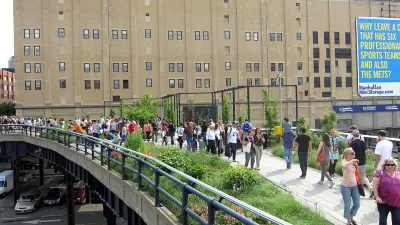As cities strive to improve the "design" and "beauty" of their buildings, how can such attributes be mandated by planning documents if their mere mention is verboten, asks Karrie Jacobs.
Jacobs looks to New York City's recently released East Midtown Study, which provides recommendations for upzoning the blocks surrounding Grand Central Terminal to produce the city's next generation of distinct towers, for a parable about the quest to remove subjective judgements of design or beauty from the planning process, in favor of objective evaluations of quality.
Jacobs is encouraged by an initial draft of the Study that included language in support of "extraordinary buildings" and "superior design," which leads her to ponder whether, "[i]n a city where the developer has always been the most powerful shaper
of built form, could city government finally be tipping the balance
toward the architect?"
In the final document, however, any mention of "design" is notoriously absent. When Jacobs questions planning director Amanda Burden about the omission, she responds: "It really can't be subjective according to somebody's
taste or whim. This is too important to the city's future,
too important to the skyline." In place of trying to judge the nebulous concept of "beauty" or "superior design", Burden contends that distinct elements such as a building's contribution to the pedestrian realm or its relationship with neighboring buildings can be measured objectively.
"At the same time she denies that the word 'design' has a place in the
East Midtown Study, Burden says that the proposed zoning is intended to
incentivize 'great new iconic structures.' But you can't achieve icon
status by adhering to a checklist," argues Jacobs. "Generally, what you get is a tall,
fat building with a novel spire on top and a spiffy subway entrance at
the base. I thought introducing a squishy, qualitative notion like 'superior design' was a good idea, quixotic for sure, but also kind of
brilliant. I had hoped-naively, as it turns out-that the city was
emitting a signal (like a dog whistle that could be heard only by
architects), saying there was room for genius in its plans."
FULL STORY: Uttering the D-Word

Alabama: Trump Terminates Settlements for Black Communities Harmed By Raw Sewage
Trump deemed the landmark civil rights agreement “illegal DEI and environmental justice policy.”

Study: Maui’s Plan to Convert Vacation Rentals to Long-Term Housing Could Cause Nearly $1 Billion Economic Loss
The plan would reduce visitor accommodation by 25% resulting in 1,900 jobs lost.

Planetizen Federal Action Tracker
A weekly monitor of how Trump’s orders and actions are impacting planners and planning in America.

Wind Energy on the Rise Despite Federal Policy Reversal
The Trump administration is revoking federal support for renewable energy, but demand for new projects continues unabated.

Passengers Flock to Caltrain After Electrification
The new electric trains are running faster and more reliably, leading to strong ridership growth on the Bay Area rail system.

Texas Churches Rally Behind ‘Yes in God’s Back Yard’ Legislation
Religious leaders want the state to reduce zoning regulations to streamline leasing church-owned land to housing developers.
Urban Design for Planners 1: Software Tools
This six-course series explores essential urban design concepts using open source software and equips planners with the tools they need to participate fully in the urban design process.
Planning for Universal Design
Learn the tools for implementing Universal Design in planning regulations.
Caltrans
Smith Gee Studio
Institute for Housing and Urban Development Studies (IHS)
City of Grandview
Harvard GSD Executive Education
Toledo-Lucas County Plan Commissions
Salt Lake City
NYU Wagner Graduate School of Public Service



























